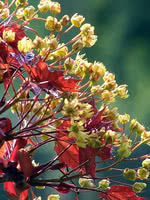Mon-Fri 9am - 5pm Mountain time
Black Cherry vs Prairie Splendor Norway Maple
Prunus serotina
Acer platanoides Prairie Splendor
NOT AVAILABLE THIS SEASON - MIGHT RETURN
NOT AVAILABLE THIS SEASON - MIGHT RETURN
Black Cherry is common in eastern North America but a rare find elsewhere. This tree is shade tolerant and is often found in old fields, forest openings, and along fencerows.
The fruit is edible and is commonly used to flavor rum and brandy. It is also edible and often eaten fresh or used in wine or jelly. Black Cherry trees typically begin producing fruit when they are 10 years of age.
Black Cherry wood is a rich reddish-brown color and is strong, making it valued in cabinetry and woodworking. It is often used in reclamation as well.
The leaves can poison livestock as they contain cyanide derivatives and precursors. However, many have noted that deer still seem to browse their trees with impunity and birds and other animals eat the fruit when available.
Prairie Splendor Norway Maple has stunning burgundy to purple foliage in every season. It is an attractive, ornamental shade tree. Bright yellow flowers form along the branches in early spring before the leaves,
It is relatively cold-hardy, but may need some protection to thrive in colder climates. With its large oval shape and dense foliage, the Prairie Splendor Norway Maple will make a great addition to your yard and provide shade once mature.
Black Cherry Quick Facts
Prairie Splendor Norway Maple Quick Facts
Toxicity: bark and wilted leaves toxic to livestock

